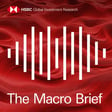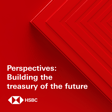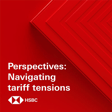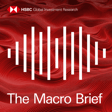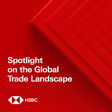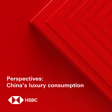Become a Creator today!Start creating today - Share your story with the world!
Start for free
00:00:00
00:00:01

Under the Banyan Tree - Asian supply chains: from politics to production
Fred Neumann and Herald van der Linde take a big-picture look at Asian supply chains, the political and economic reasons why they can be forced to shift, and the logistical operations involved in relocating them. Disclaimer To stay connected and to access free to view reports and videos from HSBC Global Research click here
Hosted on Acast. See acast.com/privacy for more information.
Transcript
Podcast Introduction
00:00:00
Speaker
Welcome to HSBC Global Viewpoint, the podcast series that brings together business leaders and industry experts to explore the latest global insights, trends, and opportunities.
00:00:11
Speaker
Make sure you're subscribed to stay up to date with new episodes.
00:00:14
Speaker
Thanks for listening.
00:00:15
Speaker
And now onto today's show.
00:00:16
Speaker
This is a podcast from HSBC Global Research, available on Apple Podcasts and Spotify.
Impact of Supply Chains on Asia
00:00:22
Speaker
Search for HSBC Global Viewpoint or join us via the HSBC Global Banking and Markets page on LinkedIn.
00:00:29
Speaker
However you're listening, analyst notifications, disclosures and disclaimers must be viewed on the link attached to your media player.
00:00:45
Speaker
Hello and welcome to Under the Banyan Tree, our weekly podcast where we put Asia in context.
00:00:50
Speaker
My name is Fred Newman, the Chief Asia Economist here at HSBC, coming to you this week from New York City.
00:00:57
Speaker
And I'm Harold van der Linde, Head of Asia Equity Strategy, and I'm currently in Singapore.
00:01:02
Speaker
We've got a pack show for you today, and it's all about supply chains.
00:01:06
Speaker
It's a topic that's never far from the headlines, with wide-ranging implications for growth and trade.
00:01:12
Speaker
and of course companies and sectors in Asia and around the world.
00:01:16
Speaker
We're going to tackle it from various angles, starting with the big picture and working our way down to the semiconductor industry where geopolitics is shaking up established Asian supply networks.
FDI Trends: Shift from China to ASEAN
00:01:26
Speaker
There's a lot to discuss, so let's begin.
00:01:34
Speaker
So Fred, why are we talking about supply chains?
00:01:38
Speaker
So there are a couple of reasons, really.
00:01:40
Speaker
One is, of course, the pandemic, because the pandemic has shown the fragility of global supply chains.
00:01:46
Speaker
There was a big shift towards demand of goods across the world.
00:01:50
Speaker
And, of course, supply chains couldn't keep up.
00:01:52
Speaker
That's now actually fading, and we see a normalization from pandemic-related demand.
00:01:57
Speaker
The trouble, really, is that there's a geopolitical element coming into supply chains as well.
00:02:03
Speaker
And that's really...
00:02:04
Speaker
This idea that some economies want to disentangle their dependence on certain other economies, namely the tech space, for example, there's a view that maybe one should put more emphasis on the security of a critical component that is secure supply chains.
00:02:23
Speaker
And that's why this idea of supply chain security, this idea of on showing fringe showing, et cetera, to have seen the headlines continues to persist.
00:02:34
Speaker
Okay, so what sort of investment trends, in particular foreign investment trends, do you see then across the region?
00:02:40
Speaker
Well, we've already seen for several years now this rejigging of supply chains being reflected in FDI flows.
00:02:48
Speaker
And while globally FDI flows, that is foreign direct investment inflows, have actually collapsed in recent years, into Asia they continue to be very strong.
00:02:58
Speaker
But there is a subtle shift here.
00:03:00
Speaker
ASEAN in particular, the Southeast Asia,
00:03:03
Speaker
continues to see very strong inflows.
00:03:06
Speaker
India is running at near record inflows as well.
00:03:09
Speaker
And to some extent, it is perhaps signaling a shift of supply chains out of China to some extent into markets like Malaysia or Vietnam, for instance, and possibly as far afield as India.
China's Continued FDI Attraction
00:03:22
Speaker
But I believe that, contrary to common belief, there's still a lot of foreign direct investments going into China.
00:03:29
Speaker
Is that correct?
00:03:29
Speaker
Why is that the case?
00:03:31
Speaker
That's right.
00:03:32
Speaker
Actually, China continues to receive near record amounts of foreign direct investment inflows.
00:03:37
Speaker
Now, that probably means that globally, companies are still looking at the Chinese market as a growth market.
00:03:45
Speaker
So the type of investment is shifting.
00:03:47
Speaker
You now invest in China to really produce for the Chinese market, and you're shifting potentially some production into Southeast Asia.
00:03:56
Speaker
So it's kind of
00:03:57
Speaker
This China plus one strategy we heard a lot about, which is big multinationals continue to invest in China because of its strong growth prospects, but at the same time creating some supply chain redundancy by shifting some production into Southeast Asia in particular, where, again, Malaysia and Vietnam are probably some of the winners.
00:04:18
Speaker
That's interesting.
00:04:19
Speaker
But I suspect that this reshuffling of supply chains across Asia impacts these trade flows across the region as well.
00:04:27
Speaker
It does, very much so.
00:04:28
Speaker
So we shouldn't really think of the complete disentangling of supply chains.
00:04:34
Speaker
Rather, we see a shift in kind of the production base for certain types of products.
00:04:40
Speaker
In particular, we see very strong trade growth between China and ASEAN, that is Southeast Asia, because, yes, we're moving some production into places like Vietnam and Malaysia, but they're still using a lot of components that are actually produced in mainland
ASEAN's Competitive FDI Strategies
00:04:55
Speaker
China.
00:04:55
Speaker
And so that's why you see
00:04:57
Speaker
trade actually between mainland China and ASEAN being so robust, it's growing very rapidly because we're not fully disentangling supply chains here.
00:05:06
Speaker
Rather, we're moving some production in Southeast Asia and we still have very, very intricate production networks across the region.
00:05:14
Speaker
Well, if companies move from China and let's say they go to ASEAN, they have a few choices.
00:05:22
Speaker
Are these countries trying to make themselves attractive?
00:05:24
Speaker
Do they invest in harbor capabilities?
00:05:27
Speaker
infrastructure, education and these sort of things?
00:05:30
Speaker
Yeah, there's a lot of competition among economies to attract more FDI, more foreign direct investment.
00:05:36
Speaker
And the competition really runs along the lines of who can provide the best infrastructure, where is labor markets perhaps more flexible, where there's sufficient labor available.
00:05:48
Speaker
And those are all factors that really were just driving policy in these economies.
00:05:53
Speaker
Some are more successful at it, some are less successful.
00:05:56
Speaker
But a key issue that's actually emerging here is labor supply.
00:06:00
Speaker
So in some ASEAN markets in Southeast Asia, we're running actually a bit into labor supply issues.
00:06:06
Speaker
And that's why some companies are looking to India because of that.
00:06:09
Speaker
Because that economy, of course, has an inexhaustible, seemingly inexhaustible death of workers where companies can draw.
Resilience of FDI in Asia
00:06:19
Speaker
Well, that's interesting because that's, of course, good news if you are in ASEAN or in India.
00:06:23
Speaker
Because you've got employment, it means you can consume differently as well.
00:06:27
Speaker
You've got wages coming up maybe.
00:06:29
Speaker
Do we see evidence of that as well?
00:06:33
Speaker
Very much so.
00:06:33
Speaker
There's linkages to the local economy.
00:06:36
Speaker
And economists talk about backward and forward linkages of foreign direct investment.
00:06:41
Speaker
And if a foreign company comes in, hires workers, it has spillover effects into the local economy.
00:06:47
Speaker
And so very much so in places across ASEAN, but also increasingly in India.
00:06:53
Speaker
There is a sense that this foreign direct investments coming in is producing employment opportunities, helping to lift consumption and so benefits really the wider economy.
00:07:04
Speaker
One remarkable thing is just how resilient this FDI flow has been in recent years right through the pandemic.
00:07:11
Speaker
And that's maybe a reason why Asia broadly has that resilience, despite all the vagaries in global markets currently from the Fed hiking interest rates to potential recession risks elsewhere.
00:07:23
Speaker
we really see FDI providing that extra amount of resilience for local growth, for balance of payments.
00:07:30
Speaker
And that's an ongoing story, really.
00:07:32
Speaker
And we're looking potentially at another record year of foreign direct investment into emerging Asia.
Factors in Supply Chain Decisions
00:07:38
Speaker
Okay, very good, Fred.
00:07:39
Speaker
We're going to take a quick break here, folks.
00:07:41
Speaker
We'll be looking at supply chains from the bottom up in just a moment.
00:07:44
Speaker
But first, though,
00:07:45
Speaker
We want to take this opportunity to invite you to join HSBC's Global Emerging Markets Forum, which will take place online from the 13th to the 30th of September.
00:07:56
Speaker
Over three weeks, policymakers, thought leaders, corporates and our team of experts here at HSBC Global Research will be sharing their views on the outlook for emerging markets.
00:08:06
Speaker
If you're interested in attending, please contact your local HSBC representative for more details.
00:08:21
Speaker
So Harold, you've looked at supply chains as well.
00:08:24
Speaker
What specific angle are you taking in your analysis?
Inertia in Supply Chains
00:08:28
Speaker
Yeah, what we've done is to look at supply chains from the bottom up.
00:08:31
Speaker
So we've looked and spoken with companies and said, why have you moved your production to this location or that location?
00:08:40
Speaker
And there seem to be four factors that always come up in those discussions.
00:08:44
Speaker
The first one is simply cost.
00:08:46
Speaker
You go to the place where it's cheaper to produce, but that's not always the overriding factor.
00:08:51
Speaker
A very important factor is what we've called competencies.
00:08:55
Speaker
Competencies means it's nice to say, well, let's go to a place where labor is much cheaper, but are they well trained?
00:09:02
Speaker
Can they actually work in your factory?
00:09:04
Speaker
If you have a semiconductor facility, do they have engineers over there, a sufficient number of engineers?
00:09:10
Speaker
It's not only that.
00:09:11
Speaker
It is also, for example, if you make a product and use plastic, you need certain plastic on the very specific kind of quality or particular specifications.
00:09:21
Speaker
you might not be able to get that in another location.
00:09:24
Speaker
So companies very often are part of a network and these competencies, raw materials, labor supply, consultants, you name it, is important as well.
00:09:33
Speaker
A third factor that always comes up as well, or very often comes up, is companies want to be close to their customers.
00:09:39
Speaker
So for certain industries, it doesn't make sense to go far away because they need to be close to their customers and understand what their customers are doing.
00:09:47
Speaker
The auto industry is maybe an example.
00:09:49
Speaker
Risks.
00:09:50
Speaker
to move to another country or the availability of finance or getting money in and out of a country are factors that sometimes play a role as well.
00:09:59
Speaker
So you're describing really a number of factors that determine supply chains, how they operate, what factors are really determining where companies put their particular production locations.
00:10:10
Speaker
Is there a degree of inertia, if you will, that once you have established certain supply chains, there's a type of stickiness to it so that
00:10:19
Speaker
actually you're not going to see supply chains move as quickly as the headlines might suggest.
00:10:25
Speaker
Absolutely.
00:10:26
Speaker
This is very important because, as I mentioned, very often people say, well, you know, the cost of labor goes up in one country, factories are going to move to another country.
00:10:35
Speaker
They only look at one of these factors that determine
Geopolitical Impacts on Tech Supply Chains
00:10:38
Speaker
it, but they don't look at the other factors that I mentioned, their competencies, risk, being close to consumers and these sort of things.
00:10:43
Speaker
So let's take, for example, the auto industry.
00:10:46
Speaker
They have to deal with higher labor costs.
00:10:49
Speaker
They could move out to another country and go there.
00:10:51
Speaker
But do they have the engineers there?
00:10:53
Speaker
Can they get the components there?
00:10:55
Speaker
Do the suppliers, can they move as well?
00:10:58
Speaker
Do they have the finance to move?
00:10:59
Speaker
All these issues come at play.
00:11:01
Speaker
So what you see, the auto industry is a nice example, actually, that they don't even want to move.
00:11:05
Speaker
They need to stay close to the consumers to understand their consumers.
00:11:09
Speaker
So they stay.
00:11:10
Speaker
But you see that part of their network, so some of the component makers or the
00:11:15
Speaker
the makers of components, for components and these sort of things, they're moving out to Vietnam or Thailand or Malaysia and elsewhere and set up there.
00:11:23
Speaker
And that impacts the trade that you were referring to.
00:11:27
Speaker
And the ones that have to stay or want to stay, for example, in China, they're going to deal with these higher costs through maybe automation and these sort of things.
00:11:36
Speaker
So is it fair to say that labor costs are less of a determining factor really in driving supply chains or the allocation decision
00:11:45
Speaker
buy companies, it's a word to put new production sites?
00:11:48
Speaker
Are we overstating the importance of labor costs here?
00:11:51
Speaker
Yeah, I think so.
00:11:52
Speaker
We often overstate the importance of labor costs.
00:11:55
Speaker
And it's not just the cost of labor, it's the quality of that labor, but it's also the quality of the raw materials that you can get.
00:12:02
Speaker
Can you ship your stuff out of a harbor there?
00:12:06
Speaker
All sorts of other factors that play a major role there.
00:12:08
Speaker
And that means that the supply chains are simply more sticky, as you mentioned, Fred.
00:12:12
Speaker
than people like to think, or the movements are much slower than very often what many people expect it to be.
00:12:22
Speaker
Now, one industry that's often mentioned where there's a big reshuffle potentially is a tech space and specifically semiconductors.
00:12:29
Speaker
And we already talked about the geopolitical sensitivities here.
00:12:34
Speaker
Have you looked at the tech space and what do you see there in terms of supply chain rejigging?
00:12:41
Speaker
Yeah, so there's a couple of things going on.
00:12:43
Speaker
First of all, China has really tried to make a big move to get into semiconductors.
00:12:48
Speaker
I used to live in Taiwan 20 years ago, and the talk was there, hey, the Chinese are really investing.
00:12:52
Speaker
They're going to compete with, for example, the Taiwanese.
00:12:55
Speaker
But we're 20 years later, and still they haven't really caught up.
00:12:58
Speaker
So some of the Taiwanese have really, and Koreans as well, have really stayed at the forefront of technology there and do that out of Taiwan.
00:13:07
Speaker
Now, the issue now here is that
00:13:09
Speaker
geopolitics play a role here, whereby they have American and Chinese consumers.
00:13:13
Speaker
So what you see here is that some of these companies are moving some of the production to, for example, to America and say, okay, we'll set up a plant in America in order to service our American clients, or they go, for example, to Europe and do that over there.
00:13:27
Speaker
So there, the movements of supply chains is really driven by, you could say, geopolitics.
00:13:33
Speaker
What it also
Consequences of Split Technologies
00:13:34
Speaker
means is that, for example, if you have one nation, say America and China,
00:13:38
Speaker
going from different technologies, and we've seen this in the past, for example, in the mobile space, that, yeah, you need different chipsets for that as well.
00:13:46
Speaker
So they might have one factory that makes chips for handsets, for American handsets, that uses a particular technology, and another factory somewhere else that makes it for the Chinese, using a very different technology as well.
00:13:58
Speaker
So you get dual-track technologies emerging in some of these industries as well.
00:14:03
Speaker
So you're talking about the risk really of splitting technology into different realms where we have rival technologies develop in different markets potentially over time.
00:14:12
Speaker
That should be highly inefficient.
00:14:14
Speaker
It sort of requires a duplication of production processes, different standards potentially developed.
00:14:21
Speaker
Is that a big headwind then when we think about the tech sector or is this actually opportunity?
00:14:28
Speaker
Yeah.
00:14:28
Speaker
That is a cost for the world.
00:14:31
Speaker
It is an inefficiency that we have to deal with and consumers probably have to pay for that at some point in time.
00:14:36
Speaker
And what you also see, for example, in the Chinese auto industry, they work on the assumption that they can't get particular chipsets from the US anymore.
00:14:43
Speaker
So they have to rejig their car design in order to deal with the chipsets that is available to them.
00:14:51
Speaker
You mentioned cars.
00:14:53
Speaker
Obviously, the new trend is towards electric vehicles.
00:14:56
Speaker
Is there a risk here of dual technologies also developing in the EV space?
00:15:03
Speaker
Absolutely.
00:15:04
Speaker
I think telcom equipment, semiconductors, EVs are some of the examples of industries where dual technology is most likely going to emerge.
00:15:14
Speaker
And there might be other industries that are not easily identifiable at the moment where this will happen as well.
00:15:21
Speaker
So Harold, really lots to talk about around supply chains and the issue is much more nuanced, I think, than the headlines would certainly suggest.
00:15:31
Speaker
But stepping away from supply chains and economics and markets, how are you spending the rest of your summer?
00:15:39
Speaker
What's on your mind at the moment?
00:15:41
Speaker
Well, as you know, I was in Indonesia and I've been visiting all sorts of temples.
00:15:47
Speaker
I met an historian there who's just done a translation of a
00:15:51
Speaker
a book written by a Buddhist in the 14th century and I got a copy of that.
00:15:57
Speaker
So I'm going to read that.
00:15:58
Speaker
That's part of my personal research efforts into the rise of what is called the Majapahit Empire in Indonesia.
00:16:06
Speaker
So that's going to be on my reading list while I'm on the plane over the next couple of weeks.
00:16:13
Speaker
But you're there in New York.
00:16:15
Speaker
What keeps you busy?
00:16:15
Speaker
What is on your mind?
00:16:18
Speaker
What's on my mind is I came down with COVID-19.
00:16:21
Speaker
The coronavirus finally caught up with me here in New York City.
00:16:25
Speaker
I managed to evade it for over two years now, but I think eventually it tracks us down one way or the other.
00:16:32
Speaker
And so this is my turn.
00:16:34
Speaker
And so really what's on my mind at the moment is getting over the hump and organizing my travel back to Hong Kong without any further glitches.
00:16:44
Speaker
So that's really on my mind for the coming days.
00:16:48
Speaker
Well, that's sad to hear, Fred, so I hope you will get over that hump very quickly and stay healthy.
00:16:55
Speaker
But that's all we've got time for on this episode of the Banyan Tree.
00:16:59
Speaker
Hopefully, you've now got a clear understanding of just how important supply chains are to Asian economies, but also how sensitive they are to various forces and how much of a ripple effect you can see for industries and economies if these networks are forced to shift.
Closing and Subscription Reminder
00:17:14
Speaker
Thank you, everybody, for joining us this week.
00:17:17
Speaker
We hope you enjoyed it and see you again next week on The Banyan Tree.
00:17:25
Speaker
Thank you for joining us at HSBC Global Viewpoint.
00:17:28
Speaker
We hope you enjoyed the discussion.
00:17:30
Speaker
Make sure you're subscribed to stay up to date with new episodes.
